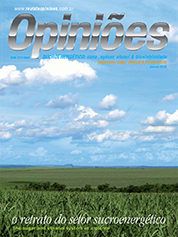Alexandre Enrico Silva Figliolino
Commercial Director of Itaú BBA
Op-AA-25
What to expect for the future?
Since the second semester of 2008, when the crisis in the sugar and ethanol industry peaked, magnified by a financial crisis of planetary proportions, we cannot complain about monotony, given that a number of merger and acquisition events took place, and even the highly volatile dynamics of sugar and ethanol markets resulted in many novelties pointing towards a new age.
Apart from the whole consolidation process involving the creation of several large groups, with an unprecedented inflow of capital to this industry, we are faced with a very healthy process in progress, in which most companies, regardless of their size, are in search of ways and are developing solutions that will allow them to remain healthy and competitive in the course of this process.
In recent years, several groups chose to sell all the capital or a controlling share of their companies as a means to solve problems they were facing, whether of a financial, corporate or successor-related nature, as well as other difficulties. In this process, more than 100 million tons of sugarcane crushing capacity changed hands, which is highly significant.
Another interesting phenomenon concerns several small, medium and large groups seeking a path we refer to as the gate-external consolidation, which currently is inherent only to the Copersucar system, constituting a very interesting model because it combines each one’s ability to well manage his business gate-inwards, while asso-ciating with an undeniably strong group of gate-external producers, for which economy of scale is more than simply essential, and involves sharing logistics, trade negotiations on a grand scale, highly professional trade management structures, commodity price variation risks, currency risks, etc.
Notwithstanding the fact that some companies have sought to unite in the purchasing area, as did the Titoto, Santa Adélia and Batatais groups and Bioagência in the sales area, it comes as a disappointment that not more groups sharing philosophical and regional affinities are talking to each other to further explore possibilities of regional mergers one might refer to as micro-consolidation, involving the creation of clusters with evident gains in scale and the increase in efficiency through the attainment of obvious synergies.
However, in general terms, the industry is in a deleveraging process due to a good 2009/10 harvest season that allowed for robust cash generation by those companies that were well structured from the operational and financial standpoint. It was a complex harvest, mainly from the price point of view, due to enormous volatility in the sugar and ethanol markets, and from the operational point of view, due to the poor taking advantage of the time factor and the low yields brought about by the rains.
These factors, among others, caused much disparity in terms of operational results, and when, for example, one analyzes the EBITDA margin on sales as shown by accounting data submitted by our clients, one finds numbers varying from zero to 40%. This, at first sight, is quite surprising when considering that these companies all produce just about the same products.
This high dispersion of results achieved by industry groups provides an idea of how enticing the future scenario may be in terms of consolidation. Another interesting aspect is to notice that for the time being results relate to management quality rather than size. What is there to expect for the future? What predictions can be made concerning the industry’s design?
1. Certainly higher concentration, in a consolidation process conducted by large groups with access to capital;
2. Increase in the number of members in Copersucar and in other similar models that may arise, and
3. Micro-consolidation processes involving mergers of groups sharing affinities, in which better structured companies will absorb less structured organizations, thus contributing to the continued existence of medium size groups in the industry, which will need to adapt to state-of-the-art management practices to compete with the large groups. To that end, it will be important for them to have corporate and succession-related matters well resolved.
4. Finally, for some time yet, we will see company units operating outside the formal system, exposed to financial and commercial vultures and pseudo-consultants, until the time of final reckoning. It is interesting to notice that differently from human beings, in the case of companies, the vultures appear before the time of final reckoning. This all makes us believe that we are on the right track to a stronger industry, more competitive, with companies better prepared to face future challenges that are quite numerous.




